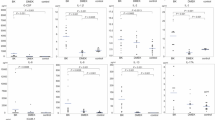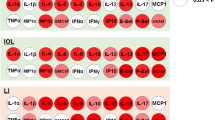Abstract
Purpose: Intra-ocular cytokine profiles were determined to study the immunological mechanisms of corneal graft opacification due to rejection and/or herpetic stromal keratitis (HSK). Methods: Sera and aqueous humour (AH) were sampled shortly after the onset of corneal graft opacification, group I (n=18). In eyes with clear grafts, samples were taken 5 months after transplantation, group II (n=59). Samples of non-inflamed eyes, prior to cataract surgery, were used to determine baseline cytokine levels, group III (n=49). Total protein (TP) levels were measured with Bradford reagent and interleukin (IL)-6, IL-10, IL-4 and interferon (IFN)-γ with ELISAs. Results: All patients who's corneal grafts showed clinical evidence of graft opacification due to rejection and/or HSK were sampled. In the AH-samples of group I, increased levels of TP were found in 60% (9/15), IL-6 in 79% (11/14), IL-10 in 39% (7/18) and IL-4 in none (0/12). IFN-γ was detected in 19% (3/16), in the case of HSK only. In contrast, samples obtained from patients with clear grafts in group II showed increased levels of TP in 36% (20/55), IL-6 in 14% (8/57) and IL-10, IL-4 or lFN-γ in none (n=58). Conclusions: During corneal graft rejection and/or HSV-infection, increased levels of TP and IL-6 in AH confirmed anterior chamber inflammation with breakdown of the blood-aqueous barrier. Based on the data presented, cytokine patterns in the AH do not appear to distinguish corneal opacification due to graft rejection from that due to herpes keratitis.
Similar content being viewed by others
References
Völker-Dieben HJM, D'Amaro J, Kok-van Alphen CC. Hierarchy of prognostic factors for corneal allograft survival. Austr N Zealand J Ophthalmol 1987; 15: 11–18.
Williams KA, Muehlberg SM, Lewis RF, Coster DJ. How successful is corneal transplantation? A report from the Australian corneal graft register. Eye 1995; 9: 219–27.
Larkin DFP. Corneal transplantation for herpes simplex keratitis. Commentary Br J Ophthalmol 1998; 82: 107–8.
Babu JS, Kanangat S, Rouse BT. T cell cytokine mRNA expression during the course of the immunopathologic ocular disease herpetic stromal keratitis. J Immunol 1995; 154: 4822–9.
Zhao ZS, Granucci F, Yeh L, Schaffer PA, Cantor H. Molecular mimicry of Herpes Simplex Virus-Type I: Autoimmune disease after viral infection. Science 1998; 279: 1344–7.
Boer de JH, Luyendijk L, Rothova A et al. Detection of intraocular antibody production to herpesviruses in acute retinal necrosis syndrome. Am J Ophthalmol 1994; 117: 201–10.
Van der Lelij A, Rothova A. Diagnostic anterior chamber paracentesis in uveitis: a safe procedure? BrJ Ophthalmol 1997; 81: 976–9.
Aurelius E, Johansson B, Sköldenberg B et al. Rapid diagnosis of herpes simplex encephalitis by nested polymerase chain reaction assay of cerebrospinal fluid. Lancet 1991; 337: 189–92.
Bradford MM. A rapid and sensitive method for the quantication ofmicrogram quantities of protein utilizing the principle of protein-dye binding. Anal Biochem 1976; 72: 248–50.
Küchle M, Vinores SA, Henderer JD, Green WD 1994. Immunohistochemical evaluation of the integrity of the blood-aqueous barrier in normal and rubeotic human eyes. Invest Ophthalmol Vis Sci 1995; 35: 1595–1600.
Nickerson P, Steiger J, Zheng XX et al. Manipulation of cytokine networks in transplantation. False hope or realistic opportunity for tolerance? Transplantation 1997; 63: 489–94.
Dallman MJ. Cytokine and transplantation: TH1/TH2 regulation of the immune response to solid organ transplants in the adult. Curr Opin Immunol 1995; 7: 632–8.
Torres PF, de Vos AF, van der Gaag R, Martins B, Kijlstra A. Cytokine mRNA expression during experimental corneal allograft rejection. Exp Eye Res 1996; 63: 453–61.
Larkin DFP, Calder VL, Lightman SL. Identification and characterization of cells infiltrating the graft and aqueous humour in rat corneal allograft rejection. Clin Exp Immunol 1997; 107: 381–91.
Balkwill FR, Burke F. The cytokine network. Immunol Today 1989; 10: 299–300.
Waal de Malefyt R, Haanen J, Spits H et al. Interleukin 10 (IL-1D) and viral IL-10 strongly reduce antigen-specific human T cell proliferation by diminishing the antigen182 presenting capacity of monocytes via downregulation of class II major histocompatibility complex expression. J Exp Med 1991; 174: 915–24.
Del Prete G, De Carli M, Almerigogna F, Grazia Giudizi M, Biagiotti R, Romagnani S.Human IL-10 is produced by both type I (TH1) and type 2 helper (TH2) T cell clones and inhibits their antigen-specific proliferation and cytokine production. J Immunol 1993; 150: 353–60.
Chen N, Gao Q, Field EH. Prevention of TH1 responses is critical for tolerance. Transplantation 1996; 61: 1076–83.
Tumpey TM, Elner VM, Chen SH, Oakes JE, Lausch RN. Interleukin-10 treatment can suppress stromal keratitis induced by herpes simplex virus type 1. J Immunol 1994; 153: 2258–65.
Rabinovitch A, Suarez-Pinzon WL, Sorensen O, Rajotte RV, Power RF. Combination therapy with cyclosporine and interleukin-4 or interleukin-10 prolongs survival of syngeneic pancreatic islet grafts in nonobese diabetic mice. Transplantation 1997; 64: 1525–31.
Lowry RP, Konieczny B, Alexander D, Larsen C et al. Interleukin-10 eliminates antiCD3 monoclonal antibody-induced mortality and prolongs heart allograft survival in inbred mice. Transplant Proc 1995; 27: 392–4.
Daheshia M, Kuklin N, Kanangat 5, Manickan F, Rouse BT. Suppression of ongoing ocular inflammatory disease by topical administration of plasmid DNA encoding IL-b. J Immunol 1997; 159: 1945–52.
Hendricks RL, Tumpey TM, Finnegan A. IFN-and IL-2 are protective in the skin but pathologic in the corneas of HSV-1 infected mice. J Immunol 1992; 149: 3023–8.
Author information
Authors and Affiliations
Rights and permissions
About this article
Cite this article
van Gelderen, B.E., Van der Lelij, A., Völker-Dieben, H.J. et al. Are cytokine patterns in aqueous humour useful in distinguishing corneal graft rejection from opacification due to herpetic stromal keratitis?. Doc Ophthalmol 99, 171–182 (1999). https://doi.org/10.1023/A:1002734709753
Issue Date:
DOI: https://doi.org/10.1023/A:1002734709753




